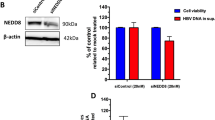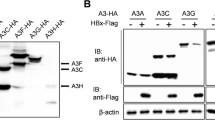Abstract
Purpose
To assess the functions of mismatched short hairpin RNAs (shRNAs) that inhibit replication and the expression of hepatitis B virus (HBV), two shRNAs possessing a 2- or 3-base mismatch that targeted HBV were studied.
Methods
shRNAs and pHY106-HBV were cotransfected into HepG2 cells. The culture supernatants were collected and used in hepatitis B surface antigen (HBsAg) and hepatitis B e antigen (HBeAg) assays. The levels of HBsAg and HBcAg mRNA were detected by reverse-transcriptase PCR (RT-PCR). HBV DNA replication intermediates were extracted for Southern blot hybridization.
Results
The results demonstrate that mismatched shRNA-458 and shRNA-635 can significantly inhibit HBsAg and HBeAg protein expression, and the maximal inhibition ratio for both proteins was found at 72 h after cotransfection: 80 and 50 %, respectively. Similar inhibitory effects were found on HBsAg and HBcAg mRNA levels and HBV DNA replication intermediates at 72 h after cotransfection, and the inhibition ratio was found to be approximately 70 and 90 %, respectively.
Conclusions
Despite the 2- or 3-base mismatch between the shRNAs and the HBV target sequences, shRNA-458 and shRNA-635 exerted a significant inhibitory effect on HBsAg and HBeAg expression and HBV replication. This indicates that mismatched shRNAs could be a promising therapy for HBV.





Similar content being viewed by others
References
Ocama P, Opio CK, Lee WM. Hepatitis B virus infection: current status. Am J Med 2005;118:1413.e15–e22
Lau JY, Wright TL. Molecular virology and pathogenesis of hepatitis B. Lancet 1993;342:1335–1340
Wands JR, Blum HE. Primary hepatocellular carcinoma. N Engl J Med 1991;325:729–731
Zoulim F, Buti M, Lok AS. Antiviral-resistant hepatitis B virus: can we prevent this monster from growing? J Viral Hepat 2007;14:29–36
Lau DT, Everhart J, Kleiner DE, et al. Long-term follow-up of patients with chronic hepatitis B treated with interferon alpha. Gastroenterology 1997;113:1660–1667
Hoofnagle JH, Di Bisceglie AM. The treatment of chronic viral hepatitis. N Engl J Med 1997;336:347–356
Lai CL, Chien RN, Leung NW, et al. A one-year trial of lamivudine for chronic hepatitis B. Asia Hepatitis Lamivudine Study Group. N Engl J Med 1998;339:61–68
Oliver S, Hueseyin S, Anneke F. Variant of hepatitis B virus with primary resistance to adefovir. N Engl J Med 2006;354:1807–1812
Deng L, Li G, Xi L, Yin A, et al. Hepatitis B virus inhibition in mice by lentiviral vector mediated short hairpin RNA. BMC Gastroenterol 2009;9:73
Ying RS, Zhu C, Fan XG, et al. Hepatitis B virus is inhibited by RNA interference in cell culture and in mice. Antivir Res 2007;73:24–30
Jia F, Zhang YZ, Liu CM. Stable inhibition of hepatitis B virus expression and replication in HepG2.2.15 cells by RNA interference based on retrovirus delivery. J Biotechnol 2007;128:32–40
Chen CC, Ko TM, Ma HI, et al. Long-term inhibition of hepatitis B virus in transgenic mice by double-stranded adeno-associated virus 8-delivered short hairpin RNA. Gene Ther 2007;14:11–19
Ansar M, Ashfaq UA, Shahid I, et al. Inhibition of full length hepatitis C virus particles of 1a genotype through small interference RNA. Virol J 2011;8:203
Ali Ashfaq U, Ansar M, Sarwar MT, Javed T, Rehman S, Riazuddin S. Post-transcriptional inhibition of hepatitis C virus replication through small interference RNA. Virol J 2011;8:112
Khaliq S, Jahan S, Ijaz B, et al. Inhibition of core gene of HCV 3a genotype using synthetic and vector derived siRNAs. Virol J 2010;7:318
Barichievy S, Saayman S, Arbuthnot P, Weinberg MS. RNA interference-based gene expression strategies aimed at sustained therapeutic inhibition of HIV. Curr Top Med Chem 2009;9:1065–1078
Sugiyama R, Habu Y, Ohnari A, Miyano-Kurosaki N, Takaku H. RNA interference targeted to the conserved dimerization initiation site (DIS) of HIV-1 restricts virus escape mutation. J Biochem 2009;146:481–489
Li X, Hong Y, Wang Q, Zhang Q, Cheng J. Cloning and expression of genotype B and C hepatitis B virus in eukaryotic cells. Chin J Infect Dis 2010;28:10–13
Ahn SH, Kramvis A, Kawai S, et al. Sequence variation upstream of precore translation initiation codon reduces hepatitis B virus e antigen production. Gastroenterology 2003;125:1370–1378
Bang G, Kim KH, Guarnieri M, et al. Effect of mutating the two cysteines required for HBe antigenicity on hepatitis B virus DNA replication and virion secretion. Virology 2005;332:216–224
Guarnieri M, Kim KH, Bang G, et al. Point mutations upstream of hepatitis B virus core gene affect DNA replication at the step of core protein expression. J Virol 2006;80:587–595
Parekh S, Zoulim F, Ahn SH, et al. Genome replication, virion secretion, and e antigen expression of naturally occurring hepatitis B virus core promoter mutants. J Virol 2003;77:6601–6612
Fire A, Xu S, Montgomery MK, Kostas SA, Driver SE, Mello CC. Potent and specific genetic interference by double-stranded RNA in Caenorhabditis elegans. Nature 1998;391:806–811
Bernstein E, Denli AM, Hannon GJ. The rest is silence. RNA 2001;7:1509–1521
Hammond SM, Caudy AA, Hannon GJ. Post-transcriptional gene silencing by double-stranded RNA. Nat Rev Genet 2001;2:110–119
Olsen PH, Ambros V. The lin-4 regulatory RNA controls developmental timing in Caenorhabditis elegans by blocking LIN-14 protein synthesis after the initiation of translation. Dev Biol 1999;216:671–680
Bass BL. Double-stranded RNA as a template for gene silencing. Cell 2000;101:235–238
Jackson AL, Bartz SR, Schelter J, et al. Expression profiling reveals off-target gene regulation by RNAi. Nat Biotechnol 2003;21:635–637
Qiu S, Adema CM, Lane T. A computational study of off-target effects of RNA interference. Nucleic Acids Res 2005;33:1834–1847
Anderson E, Boese Q, Khvorova A, Karpilow J. Identifying siRNA-induced off-targets by microarray analysis. Methods Mol Biol 2008;442:45–63
Persengiev SP, Zhu X, Green MR. Nonspecific, concentration-dependent stimulation and repression of mammalian gene expression by small interfering RNAs (siRNAs). RNA 2004;10:12–18
Amarzguioui M, Holen T, Babaie E, Prydz H. Tolerance for mutations and chemical modifications in a siRNA. Nucleic Acids Res 2003;31:589–595
Holen T, Moe SE, Sørbø JG, Meza TJ, Ottersen OP, Klungland A. Tolerated wobble mutations in siRNAs decrease specificity, but can enhance activity in vivo. Nucleic Acids Res 2005;33:4704–4710
Du Q, Thonberg H, Wang J, Wahlestedt C, Liang Z. A systematic analysis of the silencing effects of an active siRNA at all single-nucleotide mismatched target sites. Nucleic Acids Res 2005;33:1671–1677
Wang J, Zhu J, Xu G. Cross-inhibitory effect of small interfering RNA complementary to rabies virus PV strain N gene on replication of different rabies virus strains. Chin Med Biotechnol 2008;3:204–209
Osiowy C, Giles E, Tanaka Y, Mizokami M, Minuk GY. Molecular evolution of hepatitis B virus over 25 years. J Virol 2006;80:10307–10314
Arauz-Ruiz P, Norder H, Robertson BH, Magnius LO. Genotype H: a new Amerindian genotype of hepatitis B virus revealed in Central America. J Gen Virol 2003;83:2059–2073
Acknowledgements
The project was supported by the National Natural Science Foundation of China (No. 30901258), Heilongjiang Province Science Foundation for Youths (No. QC2009C20), Department of Health project of Heilongjiang Province (No. 2009-128), Doctoral Foundation of the Second Affiliated Hospital of Harbin Medical University (No. BS2009-07) and Research Fund of Capital Medical Development (2009-3152).
Author information
Authors and Affiliations
Corresponding author
Electronic supplementary material
Below is the link to the electronic supplementary material.
Rights and permissions
About this article
Cite this article
Li, X., Hong, Y., Wang, Q. et al. Short hairpin RNAs with a 2- or 3-base mismatch inhibit HBV expression and replication in HepG2 cells. Hepatol Int 7, 127–133 (2013). https://doi.org/10.1007/s12072-012-9377-0
Received:
Accepted:
Published:
Issue Date:
DOI: https://doi.org/10.1007/s12072-012-9377-0




